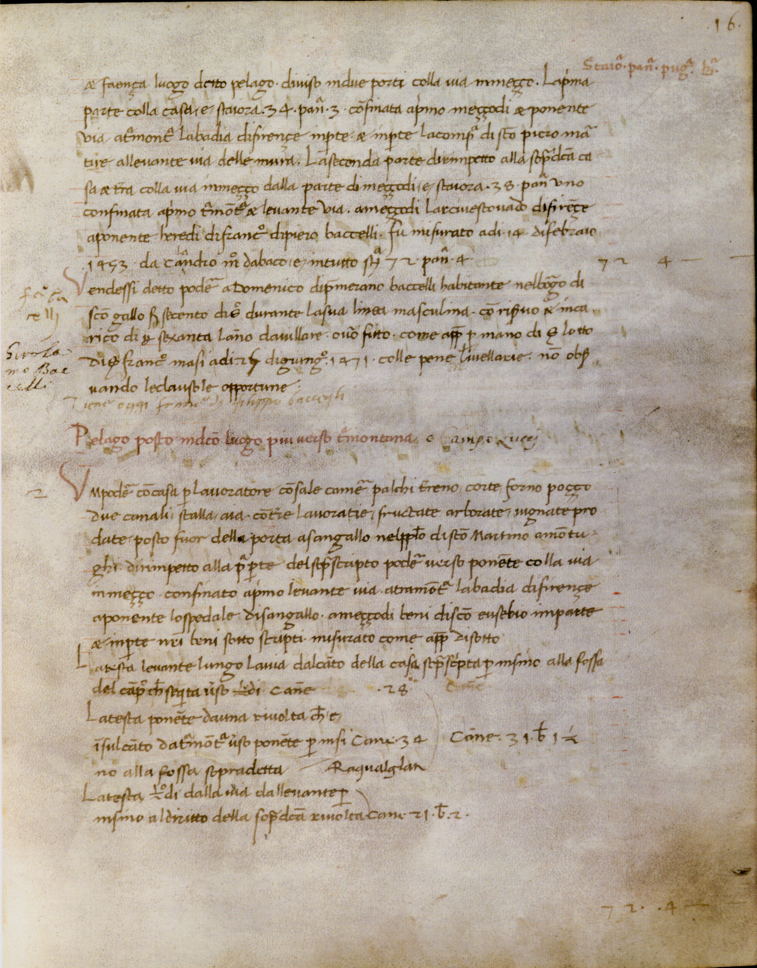|
The Exciting Recovery of a Lost Manuscript
The San Lorenzo
Palimpsest
Florence, Archivio del Capitolo di San Lorenzo, Ms. 2211
Introductory Study and Multispectral Images edited by Andreas Janke and John Nádas
Lucca, 2016. Ars Nova, Nuova Seria, 4. 17 x 24 cm, c.40, 222 pp, clothbound. $340
|

The contents of fol. 16 in the second life of the MS, an accounts book of rental properties
(click image to see what multispectral imaging reveals)
|
Of the medieval music manuscript discoveries of the recent past, one of the most unexpected and intriguing has been the palimpsest volume discovered at the church of San Lorenzo in Florence in the early 1980s. Manuscript 2211 of the church of San Lorenzo now bears the title “Campione de Beni del 1504” and details the acquisition and rental of properties up to and beyond that date. Interest in the San Lorenzo Palimpsest stems from the fact that all of its present 111 parchment leaves reveal traces of its original function: in the first decades of the Quattrocento the volume was compiled as a sizeable collection of ars nova and early fifteenth-century polyphony. Many decades later, the music manuscript was unbound, its leaves scraped clean of music and text, and then most of the source was assembled and bound as it began its reincarnation as an administrative ledger. The use of multispectral imaging has produced previously unimaginable results in going well beyond what had been possible, allowing for outstanding visibility in the final enhanced published images. This two-volume publication, including an introductory study and pseudo-color images, constitutes the virtual recovery of a lost codex, offering readings of its original musical content that make possible further scholarly study.
|
| | The
music collection contains more than 200 songs, among them those of known Trecento composers such as Jacopo da Bologna, Francesco Landini, Paolo da Firenze, and Antonio Zacara da Teramo. Most interestingly, it includes previously unknown music by the Florentines Giovanni and Piero Mazzuoli and the theorist Ugolino da Orvieto, allowing scholars a fresh examination of music in Florence in the decades surrounding the year 1400. Remarkable is the inclusion of transalpine songs and a collection of motets, which may have made their way to Florence from the Councils of Pisa and Constance and the francophile courts of Pavia and Padova. This large repertory of anonymous virelais, rondeaux, and ballades, as well as songs by Guillaume de Machaut and his contemporaries, concords with collections from northern Italy, Austria, Germany, and other international centers) in a pattern of dissemination outlined by Reinhard Strohm and others. With its newly visible contents, the San Lorenzo Palimpsest informs us of the way an era of Italian music-making was drawing to a close, telescoping with interest in the art of an international French style. The impetus for the assemblage of such a collection, in the absence of a scholarly university tradition or courtly milieu, seems to have been the continued expression of Florentine pride in native Italian polyphonic composition joined with the cultivation of some of the most cosmopolitan repertory available. |
OMI - Old Manuscripts & Incunabula PO Box 6019 FDR Station New York NY 10150
tel/fax 212/ 758-1946 • http://www.omifacsimiles.com • immels@earthlink.net
|
|
